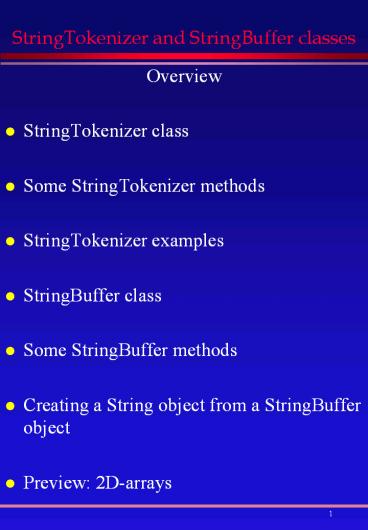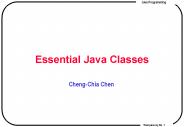StringTokenizer and StringBuffer classes - PowerPoint PPT Presentation
1 / 11
Title:
StringTokenizer and StringBuffer classes
Description:
A token is a portion of a string that is separated from another portion of that ... Modifiable (i.e., mutable) strings are supplied by the StringBuffer class of the ... – PowerPoint PPT presentation
Number of Views:164
Avg rating:3.0/5.0
Title: StringTokenizer and StringBuffer classes
1
StringTokenizer and StringBuffer classes
- Overview
- StringTokenizer class
- Some StringTokenizer methods
- StringTokenizer examples
- StringBuffer class
- Some StringBuffer methods
- Creating a String object from a StringBuffer
object - Preview 2D-arrays
2
StringTokenizer class
- A token is a portion of a string that is
separated from another portion of that string by
one or more chosen characters (called
delimiters). - Example Assuming that a while space character
(i.e., blank, \n (new line ), \t (tab), or
\r (carriage return)) is a delimiter, then the
string I like KFUPM very much has the tokens
I, like, KFUPM, very, and much - The StringTokenizer class contained in the
java.util package can be used to break a string
into separate tokens. This is particularly useful
in those situations in which we want to read and
process one token at a time the BufferedReader
class does not have a method to read one token at
a time. - The StringTokenizer constructors are
StringTokenizer(String str) Uses white space characters as a delimiters. The delimiters are not returned.
StringTokenizer(String str, String delimiters) delimiters is a string that specifies the delimiters. The delimiters are not returned.
StringTokenizer(String str, String delimiters, boolean delimAsToken) If delimAsToken is true, then each delimiter is also returned as a token otherwise delimiters are not returned.
3
Some StringTokenizer methods
- Some StringTokenizer methods are
- To break a string into tokens, a loop having one
of the following forms may be used
int countTokens( ) Using the current set of delimiters, the method returns the number of tokens left.
boolean hasMoreTokens( ) Returns true if one or more tokens remain in the string otherwise it returns false.
String nextToken( ) throws NoSuchElementException Returns the next token as a string. Throws an exception if there are no more tokens
String nextToken(String newDelimiters) throws NoSuchElementException Returns the next token as a string and sets the delimiters to newDelimiters. Throws an exception if there are no more tokens.
4
StringTokenizer examples
- StringTokenizer tokenizer new
String(stringName) - int tokenCount tokenizer.countTokens( )
- for(int k 1 k lt tokenCount k)
- String token tokenizer.nextToken( )
- // process token
- . . .
- Example1
- import java.util.StringTokenizer
- public class Tokenizer1
- public static void main(String args)
- StringTokenizer wordFinder new
StringTokenizer - ("We like KFUPM very much")
5
StringTokenizer examples (Contd)
- Example2 The following program reads grades from
the keyboard and finds their average. The grades
are read in one line. - import java.io.
- import java.util.StringTokenizer
- public class Tokenizer5
- public static void main(String args) throws
IOException - BufferedReader stdin new BufferedReader(new
-
InputStreamReader(System.in)) - System.out.println("Enter grades in one
line") - String inputLine stdin.readLine( )
- StringTokenizer tokenizer new
StringTokenizer(inputLine) - int count 0
- float grade, sum 0.0F
- try
- while( tokenizer.hasMoreTokens( ) )
- grade Float.parseFloat(
tokenizer.nextToken( ) )
6
StringTokenizer examples (Contd)
- catch(NumberFormatException e)
- System.err.println("Error - an invalid
float value read") - Example3 Given that a text file grades.txt
contains ids and quiz grades of students - 980000 50.0 30.0 40.0
- 975348 50.0 35.0
- 960035 80.0 70.0 60.0 75.0
- 950000 20.0 40.0
- 996245 65.0 70.0 80.0 60.0 45.0
- 987645 50.0 60.0
- the program on the next slide will display the
id, number of quizzes taken, and average of each
student
7
StringTokenizer examples (Contd)
- import java.io.
- import java.util.StringTokenizer
- public class Tokenizer6
- public static void main(String args) throws
IOException - BufferedReader inputStream new
BufferedReader(new
FileReader("grades.txt")
) - StringTokenizer tokenizer
- String inputLine, id
- int count
- float sum
- System.out.println("ID Number of
Quizzes Average\n") - while((inputLine inputStream.readLine(
)) ! null) - tokenizer new StringTokenizer(inputLine)
- id tokenizer.nextToken( )
- count tokenizer.countTokens( )
8
StringBuffer class
- A String object is not modifiable once created
(i.e., it is immutable). - Modifiable (i.e., mutable) strings are supplied
by the StringBuffer class of the package
java.lang - A String buffer object can be created using any
of the following constructors - Note If the capacity of a StringBuffer object is
exceeded, the buffer is automatically expanded to
accommodate the additional characters.
StringBuffer( ) Creates a StringBuffer object containing no characters in it with an initial capacity of 16 characters
StringBuffer(int size) throws NegativeArraySizeException Creates a StringBuffer object containing no characters in it with an initial capacity of size characters. Throws an exception if size lt 0
StringBuffer(String str) Creates a StringBuffer object containing str with an initial capacity of (str.length( ) 16) characters
9
Some StringBuffer methods
- The StringBuffer class has some methods that are
similar to those in the String class (e.g.,
length( ), charAt(index), substring(index),
substring(index1, index2) - The following are some of the methods of the
StringBuffer class
int length( ) Returns the number of characters in the buffer
int capacity( ) Returns the capacity of the buffer
char charAt(i) Returns the character at position i
void setCharAt(i, ch) Replaces char at i with ch
StringBuffer append(ob) Appends the string form of the object ob or a primitive value to the buffer.
StringBuffer insert(i, ob) Inserts the string form of the object ob (or a primitive value) at i
StringBuffer replace(s, f, str) Replaces the substring from s to f 1 with str
StringBuffer delete(s, f) StringBiffer deleteCharAt(i) Deletes characters from s to f - 1 Deletes the character at i
StringBuffer reverse( ) Reverses the contents of buffer.
String toString( ) Returns the contents of buffer as a string.
10
Creating a String object from a StringBuffer
object
- Example
- public class InsertTest
- public static void main(String args)
- StringBuffer sb new StringBuffer("Drink
Java!") - System.out.println(sb)
- sb.insert(6, Hot ")
- System.out.println(sb)
- Creating a String object from a StringBuffer
object - A string object can be created from a
StringBuffer object using one of the following
StringBuffer methods
String toString( ) Returns the string contained in the invoking StringBuffer object.
String substring(int index) Returns the substring from index to the end of the invoking StringBuffer object.
String substring(int index1, int index2) Returns the substring from index1 to index2 1 of the invoking StringBuffer object.
11
Creating a String object from a StringBuffer
object (Contd)
- Example
- public class ReverseString
- public static void main(String args)
- String str "What's going on?"
- System.out.println(reverseString(str))
- public static String reverseString(String
source) - StringBuffer dest new
StringBuffer(source) - dest.reverse( )
- return dest.toString( )





























![Arrays, Strings and Collections [2] PowerPoint PPT Presentation](https://s3.amazonaws.com/images.powershow.com/P1253297280hWigS.th0.jpg?_=20150705063)

